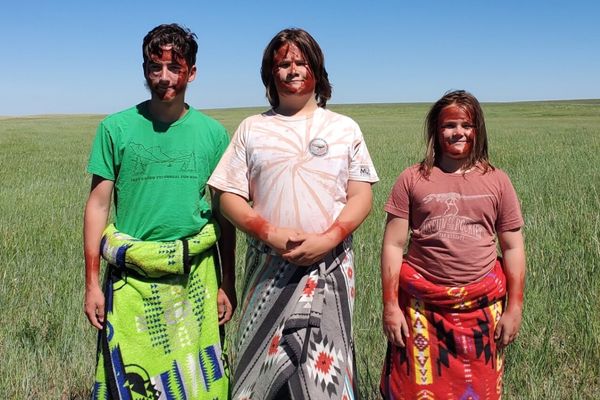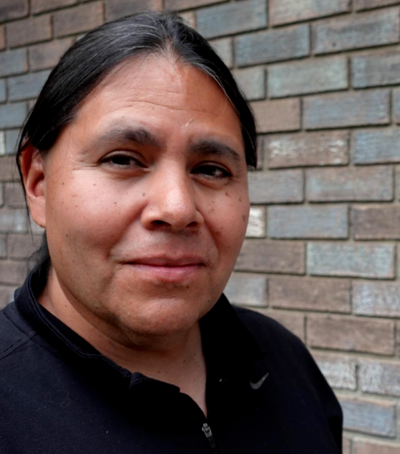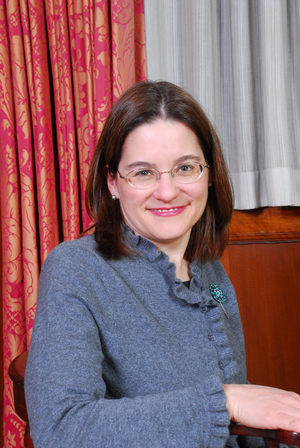
- Details
- By Elyse Wild
- Economic Development
As economic development surges across Indian Country, personal finances lag as Native communities continue to experience some of the highest rates of poverty in the nation. Several programs are driving efforts to change the tides by instilling financial literacy in Native youth to sustain economic prosperity in Indian Country for the next seven generations.
On the remote Blackfeet Reservation in East Glacier, Montana, brothers William, Sam, and Michel talk about what they are saving money for.
"I'm saving for an Xbox — or college," Michel said.
"My goal is to eventually save for college or university, specifically hoping to go to the University of Edmonton, because our mom is from Canada," William said. "We have dual citizenship."
And their brother Sam? He's not quite sure yet.
The brothers are members of the Little Shell Chippewa Tribe, which gained federal recognition in 2019. It doesn’t have a reservation, and many of the tribe's 6,200 enrolled members live in Helena and Great Falls, Montana. The three boys live with their parents on the Blackfeet Reservation — population 400 — just east of Glacier National Park and about 60 miles south of the Canadian border.
Their mom, Denise, describes the area as bustling in the summer months, with more than 3 million visitors flocking to the park each season. It was one of the 10 most visited national parks last year.
But in the winter, "It's the model of isolation," she said. "It's very rural."
Glacier County, with about 14,000 people spread over 3,000 square miles, is one of Montana’s poorest areas. It ranks 54th among the state's 56 counties in per capita income, at $17,053 a year.
For Denise, instilling financial literacy in the boys at an early age is essential for them to avoid the stress of poverty.
"I'm trying to get them into the rhythm of earning and saving," Denise said.
The three brothers have spent the past year making weekly deposits into their personal savings accounts through the Blackfeet Mini-Bank, a program of Native American Community Development Corporation Financial Services, Inc. (NACDC) in Browning, Montana. They started building their funds when they took a job walking a neighbor's dog last winter. Each week, their neighbor would give the boys’ mother a check, and they would carefully divide the sum among themselves. Denise saw it as an opportunity for the boys to learn how to open and manage a bank account.
The Mini-Bank, launched in 1996, is one of 19 Native Children's Savings Account Initiatives across Indian Country, according to a report by the Oklahoma Native Assets Coalition (ONAC). The savings programs are designed to instill financial literacy in Native youth, as part of a push for asset-building in Indian Country.
From the first contact with Europeans to the Indian Removal Act of 1830 and beyond, the sanctioned stripping of Native culture and resources, combined with government ignorance of Indigenous needs, has had devastating economic effects on Indian Country. Despite what appears to be surging economic development among Tribes, Native Americans have the highest poverty rate of any major U.S. ethnic group, with one in four living below the federal poverty level, according to the Census Bureau’s American Community Survey.
Limited access to banks in the isolated areas where many Indigenous communities live has left cavernous gaps in basic financial services and asset-building opportunities. But since 1994, when the federal Community Development Financial Institutions Fund created the Native Initiatives program to support the creation of community development financial institutions in Indian Country, Native CDFIs have filled some of that gap.
Today, tribal enterprises reach far beyond casinos to energy, global logistics, tourism, and more. And, as the Tribal Broadband Connectivity Fund pours billions of dollars in grants into Native communities to establish high-speed Internet, more opportunities will soon abound.
But, according to Native financial education consultant Shawn Spruce, none of this economic development will matter if individual tribal members lack basic financial literacy — and the key to building sustainable Native economies may lie in the financial education of Native youth.
"Some of these tribes have billion-dollar economies," Spruce told Tribal Business News. "If your tribal members can't balance a checkbook, don't know how to use a credit card, and don't understand the importance of saving for retirement or saving for the future, then none of that success matters if people at the community level can't share in their financial success."
Financial education for youth appears to correlate with both their families’ economic well-being and financial outcomes in adulthood. The 2020 U.S. National Strategy for Financial Literacy reported that white and Asian 15-year-olds, on average, had substantially higher financial literacy scores than the national average for their age, while Hispanic and black students averaged substantially lower scores. According to the Federal Reserve Bank of Minneapolis, white Americans hold 84% of total U.S. wealth while making up 60% of the population; black Americans, 13% of the population, hold only 4% of the wealth.
 First Nations Development Institute financial educator Shawn Spruce. (courtesy photo)Spruce (Laguna Pueblo) is a financial educator at the First Nations Development Institute, a nonprofit focused on strengthening Native communities through economic development. He has spent the past 15 years traveling Indian Country to provide financial education tailored to the needs of individual tribes. In 2021, he was awarded the Ketchum Prize from the FINRA Investor Education Foundation — the philanthropic arm of the Financial Industry Regulatory Authority, the federally authorized nonprofit that oversees the securities industry and stockbrokers — for his commitment to providing Indian Country with the resources and information to build assets.
First Nations Development Institute financial educator Shawn Spruce. (courtesy photo)Spruce (Laguna Pueblo) is a financial educator at the First Nations Development Institute, a nonprofit focused on strengthening Native communities through economic development. He has spent the past 15 years traveling Indian Country to provide financial education tailored to the needs of individual tribes. In 2021, he was awarded the Ketchum Prize from the FINRA Investor Education Foundation — the philanthropic arm of the Financial Industry Regulatory Authority, the federally authorized nonprofit that oversees the securities industry and stockbrokers — for his commitment to providing Indian Country with the resources and information to build assets.
Spruce's passion for spreading tools for financial wellness to Native youth is rooted in his own experience. He spent his childhood in Albuquerque, New Mexico, before moving to Ann Arbor, Michigan, He describes how, when he was a child, the financial shock for his family from his father's death was mitigated by his mother's diligence.
"We grew up middle-class," he said. "We ultimately had to move into a smaller house. It wasn't a huge upheaval — she had a very good job as a nurse and was always very frugal, careful with money, and about using debt."
When Spruce turned 18, he came into insurance money from his late father — and he suddenly found himself with a significant five-figure sum.
"Everyone around me was worried because I was young," Spruce said. "The first thing my mom said was, 'Don't blow it.' That was in one ear and out the other."
Spruce says he didn't "completely blow it." He stretched the sum out for a few years and used it to go to college.
He compares his own experience with that of tribal youth who turn 18 and receive their lump-sum per-capita payment.
“Per-cap” payments are issued to individual tribal members, based on revenue from tribal enterprise, land settlements, or mining trusts. Not all tribes issue per-cap payments, but among those that do, the amounts vary widely, from as little as a few hundred dollars a year to over $100,000.
Payments for Native youth in those tribes are held in a tribally administered trust fund account, where it accrues interest until they have access to it when they turn 18.
Per-cap payments have long been a point of contention in Indian Country. A 2007 report by the University of Arizona’s Native Nations Institute for Leadership, Management, and Policy quoted two tribal leaders who said they led to a high dropout rate, drug and alcohol abuse among Native youth, and a “why bother?” attitude about education.
That report also outlined strategies some tribal nations have implemented to curb these effects, such as requiring youth to obtain a high-school diploma or a GED, sometimes even a college diploma, to be able to receive their full payment. Others require youth to undergo financial-literacy training, which is where Spruce comes in.
When Spruce started working with Native kids in per-cap tribes, he said he was surprised to learn they were getting the same advice he got all those years ago — "Don't blow it."
"I thought, 'We have to do better,'" he said. "What do we even mean by 'Don't blow it'?"
"I start by telling them I am excited for them because it is an exciting and unique opportunity," he explained. "And we can embrace that."
Spruce's trainings are interactive and tactile. He created a simulation called Spending Frenzy, where youth receive fake money in the sum they will receive from their per-cap trust disbursement. Through the simulation, they buy goods and services, pay bills, and navigate emergencies, opportunities, and risks.
The timing of this trial run is crucial, he says.
"We do it just a month or two before they get their disbursements," Spruce explained. "The data supports that financial education needs to be timely — it needs to be relevant to a person's needs and interests. The timing is everything."
The majority of his work, however, is with non-per-cap tribes, where he teaches Native youth the importance of record-keeping and creating systems — whatever they may be — that work.
"It's very much geared around developing a system that works for you, something that's not overly complicated," Spruce said. "If you want to use an app, that's great. If you want to use a shoebox — whatever is at your disposal, just figure out a system that works for you.
“And these are life skills — it won't just help them with money, it will help with school and getting a job. It's about giving kids the tools and resources to help them get to first base, and then to second, third and eventually to home plate."
For many Native families, that home plate is college, says Christy Finsel (Osage), executive director of ONAC. The coalition is an intermediary funder, direct service provider, and national coordinator of two Native asset-building networks. While located in Oklahoma, its services are available nationwide.
ONAC's Children’s Savings Accounts Program was launched in 2014 and is primarily geared toward helping Native youth save for college through 529 Savings Plans. A 529 plan is a state-sponsored investment plan that enables you to save money for a beneficiary to pay for their education expenses. You can withdraw funds tax-free to cover nearly any type of college expense. ONAC provides an initial seed deposit of $100.
 ONAC Executive Director Christy Finsel (courtesy photo)Finsel says the organization aims to bridge the gap in Native American college attendance and graduation rates and, by extension, the racial wealth gap.
ONAC Executive Director Christy Finsel (courtesy photo)Finsel says the organization aims to bridge the gap in Native American college attendance and graduation rates and, by extension, the racial wealth gap.
"We want to help families to start to think about college and start saving for it," she told Tribal Business News.
While Native Americans have made significant gains in high-school graduation rates, with three-quarters of the population age 25 and older holding a high-school diploma, college graduation rates remain low. Only 15% of American Indians have a college degree — less than half the national average, according to the American Indian College Fund.
ONAC's website points to a study by the Center for Social Development at Washington University in St. Louis and the New America Foundation, in which researchers found that youth who have a savings account specifically for college are seven times more likely to attend college than those who do not.
"We know that Native communities and Native families have the lowest rates of college savings in the country," Finsel said. "The lowest rates for saving for emergency savings accounts and so forth. We are trying to shift that narrative."
She notes that asset-building in Native communities goes beyond dollars and cents.
"We think about asset building as an integrated approach and a culturally relevant one," Finsel said. "That means thinking about assets beyond money and incorporating arts, language, culture, and community into the programming. Native communities have been very receptive to that approach."
Back in East Glacier, Matt Harrington runs the Blackfeet Mini-Bank each week, traveling to five schools in the area, where he sets up a table and holds banking hours with students. During those hours, kids engage in a process that mimics the banking system: they can open an account by submitting a permission slip from their parents or guardians and making an initial deposit of $3, fill out deposit slips to add money to their accounts, or make withdrawals.
Harrington then takes the money and deposit slips to the Native American Bank, where the accounts — which the Native American Community Development Corporation has custody of — are held. The program matches savings up to $200, which Harrington says helps students focus on their goals.
"The overall goal is to help the kid save money," Harrington said. "For them to get the match, they have to build on their own goals. So we have them do an annual goal and then an overall goal for when they reach the end of high school."
Today, along with the brothers William, Sam and Michel, 290 other Native students participate in the Blackfeet Mini-Bank. Some, Harrington says, have saved around $1,000.
Harrington says he is often moved by the excitement in the students when they see their money starting to pile up.
"Very often during the banking hours at school during lunch, a kid will come up to me and ask how much money they have in their account," he said. "Once I tell them, they'll nod with a satisfied look and then just walk away."
William, Sam, and Michel have saved $150, $230, and $180, respectively, in their Mini-Bank accounts.
At this time, the Little Shell tribe doesn’t issue per-cap payments. The boys build their savings through odd jobs for neighbors and doing chores at home in exchange for an allowance. When Michel describes what the mini-bank program has taught him, he says, "I've learned that when you put away money, in a little while, you'll get some more back."
Denise hopes that encouraging the boys to continue to earn money and stay focused on their financial goals will help them feel like they are on solid ground when they leave home, so they won't fall prey to the pitfalls of financial stress.
"I am hoping they will feel competent enough with their financial education that money isn't a stress for them when they leave home and go out on their own," she said. "Knowing how to manage their money will make it not a stress in their lives."
“It doesn't matter how much money you have. You can have next to none, and it's a stress, or you can have too much, and it can be a stress. It's about how you manage your life."
